 2-Winding Transformer. The pointer changes to a 2-winding transformer symbol.
2-Winding Transformer. The pointer changes to a 2-winding transformer symbol.Click  2-Winding Transformer. The pointer changes to a 2-winding transformer symbol.
2-Winding Transformer. The pointer changes to a 2-winding transformer symbol.
Place the transformer by positioning the top of the pointer onto the upper bus and clicking once. The transformer automatically attaches to the bus, and the top half of the symbol turns black. If the entire transformer remains red (indicating it did not connect), change to the arrow pointer and drag the symbol into position.
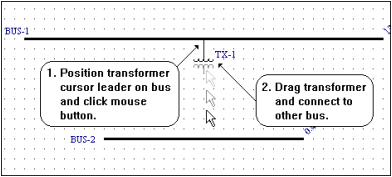
Figure 1: Positioning a Transformer
With the pointer in  Select mode, drag the transformer's bottom leader to the middle bus. After it connects, drag the transformer symbol so that it is centered between the two buses.
Select mode, drag the transformer's bottom leader to the middle bus. After it connects, drag the transformer symbol so that it is centered between the two buses.
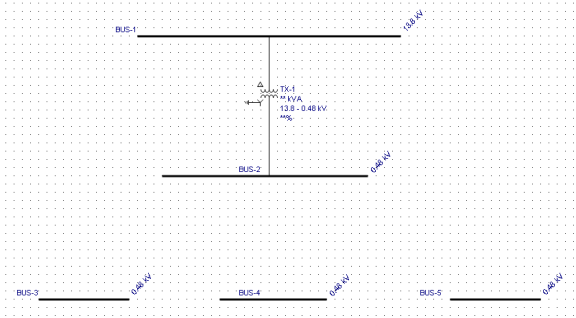
Figure 2: Transformer Connected at Both Ends
Click  Cable. The pointer changes to a crosshair. Put the crosshair on the middle bus and press and hold the left mouse button. This sets one end of the line. Now drag the crosshair to the left bottom bus and release the mouse button. This places the cable. If you miss (no cable is added), just try again.
Cable. The pointer changes to a crosshair. Put the crosshair on the middle bus and press and hold the left mouse button. This sets one end of the line. Now drag the crosshair to the left bottom bus and release the mouse button. This places the cable. If you miss (no cable is added), just try again.
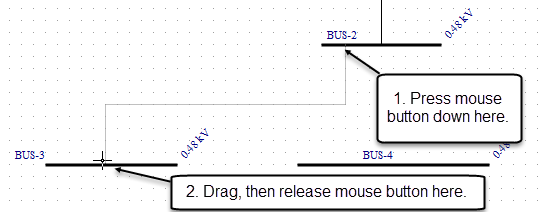
Figure 3: Adding Cable
Do the same thing for the other two cables as shown. Note that the middle cable doesn't have a jog because you moved the line straight down rather than diagonally.

Figure 4: Cables Added
Click  Motor. The pointer changes to a motor symbol.
Motor. The pointer changes to a motor symbol.
Place the first motor by positioning the motor leader on the bottom left bus with the pointer and clicking once. The motor automatically attaches to the bus, and the symbol turns black. If the motor remains red and does not connect, use the selection pointer to drag the symbol into position.
Continue by placing the other motors as shown.
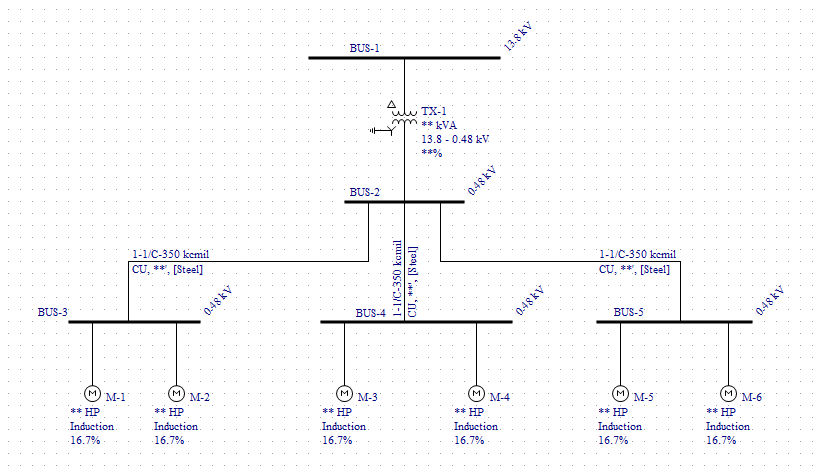
Figure 5: Adding Motors
Click  Utility. The pointer changes to a utility symbol.
Utility. The pointer changes to a utility symbol.
Place the utility on the top bus with the same procedure used for motors.
If you scroll up slightly (by clicking scroll bar on the far right) you can drag the utility symbol a little higher so there is more room to display the utility data text.
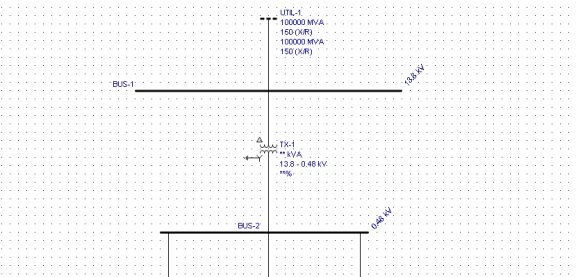
Figure 6: Adding a Utility
Click  LV Breaker. The pointer changes to a low voltage breaker symbol.
LV Breaker. The pointer changes to a low voltage breaker symbol.
Position the breaker pointer directly over a feeder line (such as a cable or transformer) and left-click. The breaker is inserted into the line.
If the breaker remains red and does not insert into the line, use the selection pointer to click on the breaker, and then delete it by clicking  . You can place the breaker again.
. You can place the breaker again.
Continue by placing the breakers shown here.
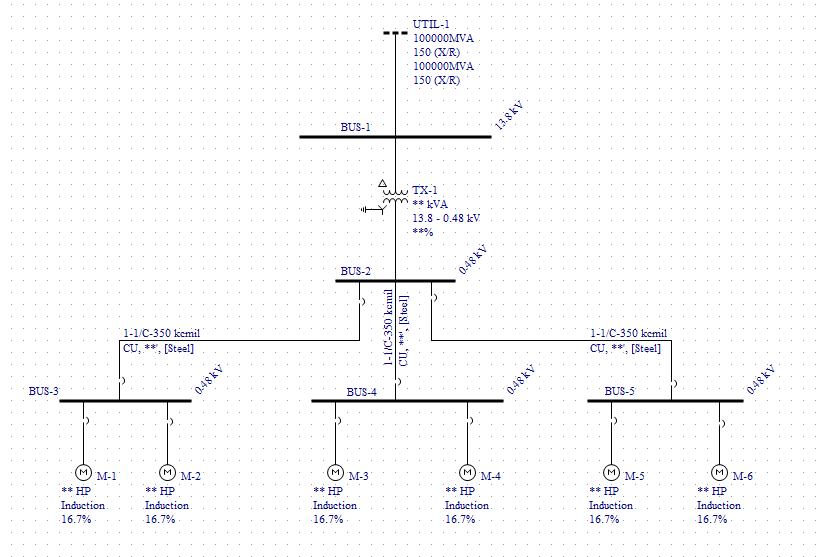
Figure 7: LV Breakers Added
Tip: You can move the breaker in vertical or horizontal directions on the one-line by dragging it with the mouse.
Adding a tie breaker is similar to adding a transformer.
Click  LV Breaker. Place the breaker by positioning the top leader of the breaker on the right end of the bottom middle bus and clicking once (see diagram below). The breaker automatically attaches to the bus. If the breaker remains red and does not connect, use the selection pointer to drag the symbol into position.
LV Breaker. Place the breaker by positioning the top leader of the breaker on the right end of the bottom middle bus and clicking once (see diagram below). The breaker automatically attaches to the bus. If the breaker remains red and does not connect, use the selection pointer to drag the symbol into position.
Right-click on the breaker you just added. Select Rotate > 90°. The breaker orientation changes from vertical to horizontal. At the same time, the connection type of the breaker changes from feeder breaker to bus tie breaker. Drag the tie breaker's remaining leader to the bottom right bus. After it connects, drag the tie breaker's symbol so it is centered between the two buses.
You can also add a vertical tie breaker between two buses if one bus is above the other. In this case, the orientation of the breaker does not need to change.
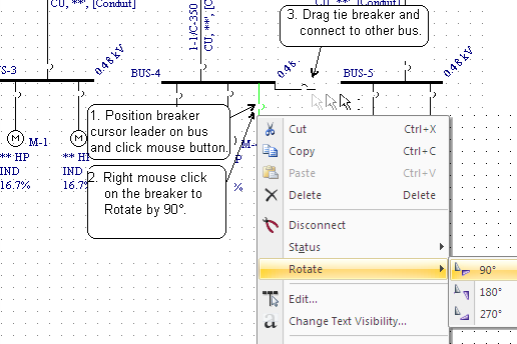
Figure 8: Adding Tie Breaker
Double-click the tie breaker to open the LV Breaker Data dialog box. Set the breaker to Open and click OK. This makes it a normally open tie breaker.

Figure 9: Open Tie Breaker
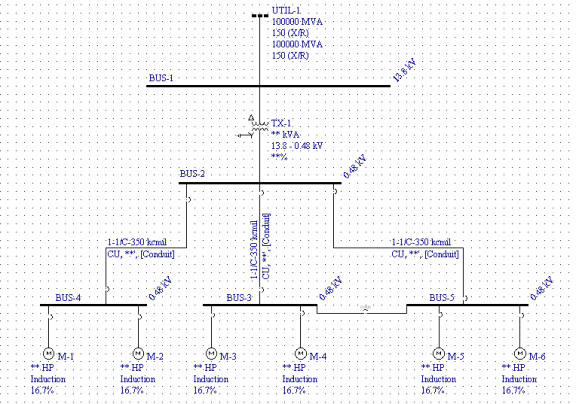
Figure 10: Tie Breaker Added
| Place Buses on the One-line | |
| Save Your Work |